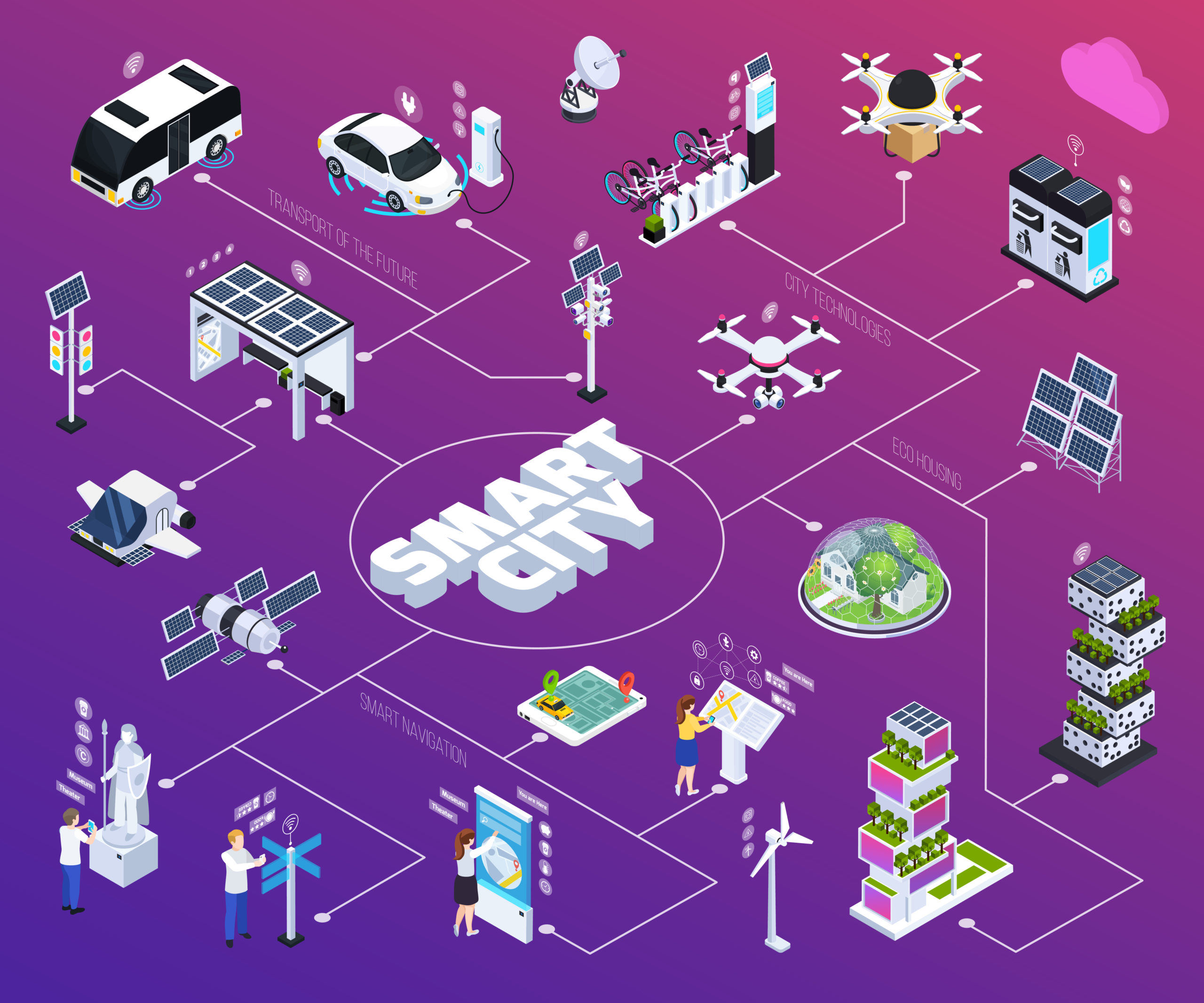What Is a Smart City and Why Are They Essential?
Smart cities are urban centers that heavily rely on an Information and Communication Technologies (ICT) framework to address the challenges posed by rapid urbanization and strive for sustainable development. These cities employ a network of interconnected IoT devices, such as sensors, lighting systems, and meters, to gather and analyze data efficiently. Citizens actively engage with smart city solutions through their smartphones, connected vehicles, and smart homes.
The primary purpose of smart cities is to harness the transformative potential of technology and data to enhance the overall quality of life for their residents, promote sustainability, and optimize the delivery of essential services. Let’s delve into a few compelling reasons why the concept of IoT in smart cities is indispensable:
- Resource Management Optimization: Smart cities leverage cutting-edge technologies like the Internet of Things (IoT), artificial intelligence (AI), and big data analytics to achieve optimal utilization of vital resources like energy, water, and transportation. This strategic approach often results in substantial cost savings, reduced wastage, and significantly heightened operational efficiency.
- Enhanced Quality of Life: The core objective of smart cities is to enrich the lives of their citizens in multiple dimensions. By harnessing data and technology, these cities can offer superior healthcare, education, and public safety services. Moreover, they facilitate easier access to information and encourage active civic participation, thereby uplifting the overall quality of life.
- Sustainability Amplification: Sustainability is a cornerstone of smart cities. They achieve this by reducing energy consumption, championing renewable energy sources, and minimizing waste generation. These green initiatives contribute to mitigating the adverse effects of climate change and bolster the resilience of cities in the face of environmental challenges.
- Economic Prosperity: Smart cities act as catalysts for economic development. They attract new businesses, leading to job creation and economic growth. Furthermore, these cities enhance the efficiency of existing businesses, ultimately invigorating the local economy.
In sum, smart cities represent a visionary approach to crafting urban environments that are not only more livable but also sustainable and efficient. They are well-equipped to address the contemporary needs of their residents while simultaneously preparing for future challenges. In essence, smart cities are a testament to the harmonious integration of technology, data, and urban planning for the betterment of society.
Five Key Factors of a Smart City
1.Technology Integration:
Smart cities seamlessly integrate technology across various sectors, such as transportation, healthcare, and utilities, to enhance connectivity and service delivery.
2. Data-Driven Decision-Making:
Data is the lifeblood of smart cities. They rely on comprehensive data collection and analysis to make informed decisions and improve services.
3. Sustainability:
Smart cities prioritize sustainability by implementing eco-friendly solutions for energy, waste management, and transportation to reduce their environmental footprint.
4. Citizen-Centric Approach:
The needs and well-being of citizens are at the forefront of smart city initiatives. Services are designed to enhance the quality of life for residents.
5. Efficient Governance:
Smart cities adopt digital governance models to streamline administrative processes, enhance transparency, and improve citizen engagement.
Four Objectives of Smart Cities
1. Enhanced Quality of Life:
The primary objective is to improve the living conditions of residents through better services, healthcare, education, and public safety.
2. Optimized Resource Management:
Smart cities aim to efficiently manage resources such as water, energy, and transportation to reduce waste and costs.
3. Environmental Sustainability:
Sustainability is a core goal, with efforts focused on reducing greenhouse gas emissions and conserving resources.
4. Economic Development:
By fostering innovation and attracting businesses, smart cities drive economic growth and create job opportunities.
How IoT is Used in Smart Cities
IoT plays a pivotal role in smart cities by connecting various devices and systems to gather and analyze data. It enables real-time monitoring and control of urban infrastructure. Here are some ways IoT is used:
- Smart Transportation: IoT sensors on roads and in vehicles optimize traffic flow, reduce congestion, and enhance public transportation.
- Environmental Monitoring: IoT devices measure air quality, detect pollution, and monitor water quality to ensure a healthier environment.
- Waste Management: Smart bins equipped with sensors notify authorities when they need emptying, reducing operational costs and traffic congestion.
Examples of IoT Smart Cities in India and Abroad
- India: The city of Jaipur in India has initiated the “Jaipur Smart City” project. It includes smart lighting, intelligent traffic management, and the use of IoT to monitor and reduce water wastage.
- Abroad: Singapore is a global example of a smart city. It employs IoT extensively for traffic management, public safety, and environmental monitoring.
Smart City Implementation Model
Smart city implementation typically follows these phases:
- Planning: Identifying goals, assessing existing infrastructure, and developing a roadmap for implementation.
- Infrastructure Development: Building the necessary physical and digital infrastructure, including IoT networks.
- Technology Integration: Implementing IoT solutions and other technologies to enhance services and data collection.
- Testing and Optimization: Running pilot projects, collecting data, and fine-tuning systems for efficiency.
- Scaling: Expanding smart city solutions to cover a broader area and involve more citizens.
Advantages of Incorporating IoT in Smart Cities
Smart cities that harness the potential of IoT rely on an integrated ecosystem of applications, interconnected systems, buildings, devices, and more to establish efficient urban living and working environments. The following are just a few of the myriad benefits it brings:
1. Enhanced Infrastructure Management:
IoT technology plays a pivotal role in overseeing and regulating a city’s infrastructure, encompassing crucial elements such as bridges, road networks, and buildings. This capability aids in promptly identifying maintenance requirements, reducing downtime, and ultimately enhancing overall safety.
2. Elevated Public Safety:
IoT-driven sensors and surveillance cameras contribute significantly to bolstering public safety. They excel in detecting potential security threats, monitoring criminal activities, and tracking the response times of emergency services.
3. Optimized Transportation:
IoT solutions optimize public transportation routes, mitigating traffic congestion and improving the flow of vehicles. Furthermore, interconnected vehicles can communicate both among themselves and with traffic management systems, fostering safer and more efficient travel experiences.
4. Energy Efficiency:
IoT technology enables meticulous monitoring and efficient management of energy consumption in buildings and public spaces. This leads to reduced energy wastage and substantial cost savings.
5. Streamlined Waste Management:
IoT sensors offer a boon to waste management. They facilitate the optimization of waste collection routes, effectively curbing the environmental impact of garbage disposal while simultaneously lowering associated costs.
6. Enhanced Citizen Engagement:
IoT platforms empower citizens to actively participate in city planning processes. They facilitate real-time feedback on urban services and enable the prompt reporting of issues, thereby fostering a more engaged and responsive civic community.
7. Health and Wellness:
IoT finds application in monitoring air quality, detecting environmental hazards, and tracking health trends. This valuable data equips public health officials with insights to formulate policies aimed at improving the health and well-being of residents.
In conclusion, the integration of IoT into the framework of smart cities yields a multitude of benefits. It not only enhances the quality of life for city dwellers but also fuels innovation, propels economic growth, and contributes to the creation of a more sustainable and resilient urban future. The synergistic potential of IoT in smart cities is poised to revolutionize urban living for the better.
Conclusion
Smart cities represent the future of urban living. By embracing IoT technology and adhering to key objectives, they can enhance the well-being of their residents, optimize resource management, promote sustainability, and foster economic growth. The IoT smart cities holds the promise of more efficient, connected, and livable urban environments for generations to come.






